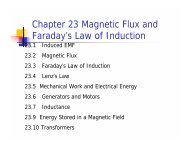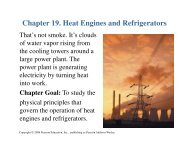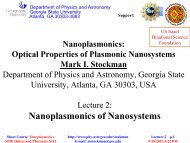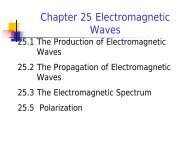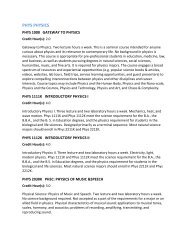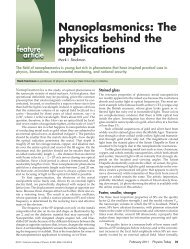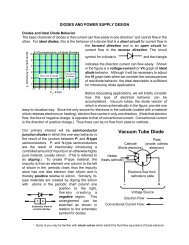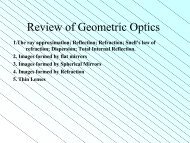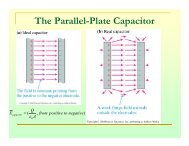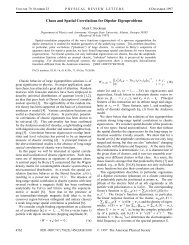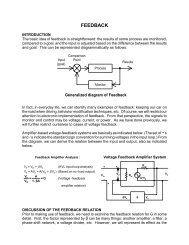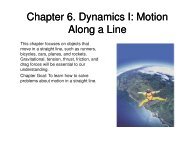Homework 11âhelp 16.12. Solve: Let F Ï Ï Ï Ï
Homework 11âhelp 16.12. Solve: Let F Ï Ï Ï Ï
Homework 11âhelp 16.12. Solve: Let F Ï Ï Ï Ï
Create successful ePaper yourself
Turn your PDF publications into a flip-book with our unique Google optimized e-Paper software.
<strong>Homework</strong> 11—help<br />
16.8. (a) The ideal-gas law says<br />
1 <br />
<br />
V<br />
pV 1<br />
2 2<br />
3p<br />
<br />
1<br />
3<br />
(b)<br />
2<br />
<br />
T2 T1 T1 T1.<br />
pV<br />
1 1 p1 V1<br />
2<br />
<br />
pV pV pV 3p 2V<br />
<br />
T T T 6T<br />
<br />
1 1 2 2 2 2 1 1<br />
2 1 1 1<br />
T1 T2 pV<br />
1 1<br />
p1 V1<br />
<strong>16.12.</strong> <strong>Solve</strong>: <strong>Let</strong> TF TC T :<br />
T T 32T T 32T<br />
40<br />
F<br />
9 9<br />
5 C<br />
5<br />
That is, the Fahrenheit and the Celsius scales give the same numerical value at 40 .<br />
Assess: It is usually unnecessary to specify the scale when the temperature is reported as 40 .<br />
16.20. Model: Treat the oxygen gas in the cylinder as an ideal gas.<br />
<strong>Solve</strong>: (a) The number of moles of oxygen is<br />
M 50 g<br />
n 1.563 mol 1.6 mol<br />
M 32 g mol<br />
(b) The number of molecules is<br />
mol<br />
<br />
<br />
N nN A<br />
1.563 mol 6.0210 mol 9.4110 9.4<br />
10<br />
2<br />
(c) The volume of the cylinder V r L <br />
(d) From the ideal-gas law pV<br />
23 1 23 23<br />
2 2 3<br />
0.10 m 0.40 m 1.257 10 m . Thus,<br />
N<br />
V<br />
23<br />
9.4110<br />
7.510 m<br />
2 3<br />
1.257 10 m<br />
25 3<br />
nRT we can calculate the absolute pressure to be<br />
1.563 mol8.31 J mol K293 K<br />
nRT<br />
p 303 kPa<br />
2 3<br />
V<br />
1.257 10 m<br />
where we used T 20C 293 K. But a pressure gauge reads gauge pressure:<br />
pg p1 atm 303 kPa 101 kPa 202 kPa 200 kPa<br />
16.69. Model: Assume that the compressed air is an ideal gas.<br />
<strong>Solve</strong>: (a) Because the piston is floating in equilibrium,<br />
where the piston’s cross-sectional area A<br />
490 N. Thus,<br />
F ( p p ) Aw<br />
0 N<br />
net 1 atoms<br />
2 2 3 2<br />
( r ) (0.050 m) 7.854 10 m and the piston’s weight w (50 kg)(9.8)<br />
w<br />
490 N<br />
p1 patmos <br />
3 2<br />
A 7.85410 m<br />
<br />
Using the ideal-gas equation 1 1 1<br />
5 5<br />
1.013 10 Pa=1.637 10 Pa
5<br />
(1.637 10 Pa)Ah<br />
1<br />
(0.12 mol)(8.31 J/mol K)[(273 30) K]<br />
With the value of A given above, this equation yields h1 0.235 m 23.5 cm.<br />
(b) When the temperature is increased from T1<br />
303 K to T2 (303 100) K 403 K, the volume changes from V1 Ah1<br />
V Ah at a constant pressure p . 2<br />
p 1<br />
From the before-and-after relationship of the ideal gas:<br />
to<br />
2 2<br />
p1( Ah1) p2( Ah2)<br />
<br />
T T<br />
1 2<br />
p1 T2<br />
403 K <br />
h2 h1<br />
1 0.235 m0.313 m 31.3 cm<br />
p2 T1<br />
303 K <br />
Thus, the piston moves h2 h1 7.8 cm.<br />
16.58. Model: The gas is an ideal gas.<br />
<strong>Solve</strong>: (a) Using the ideal-gas equation,<br />
pV<br />
nR<br />
5 3<br />
1.010 Pa2.0 m <br />
1 1<br />
1<br />
<br />
T<br />
80 mol8.31 J mol K<br />
301 K<br />
Because points 1 and 2 lie on the isotherm, T2 T1 301 K. The temperature of the isothermal process is 301 K.<br />
(b) The straight-line process 1 2 can be represented by the equation<br />
p(3 V) 10<br />
where V is in m 3 and p is in Pa. We can use the ideal gas law to find that the temperature along the line varies as<br />
5<br />
pV<br />
2 10<br />
T (3 V V<br />
) <br />
nR<br />
nR<br />
We can maximize T by setting the derivative dT/dV to zero:<br />
At this volume, the pressure is<br />
dT<br />
10 3<br />
(32 V ) 0 m 1.50 m<br />
dV<br />
nR<br />
2<br />
5<br />
2 3 3<br />
max<br />
Vmax<br />
5<br />
pmax = 1.5 10 Pa and the temperature is<br />
5<br />
T<br />
p V<br />
nR<br />
<br />
(80 mol)(8.31 J/mol K)<br />
5 3<br />
max max<br />
(1.50 10 Pa)(1.5 m )<br />
max<br />
<br />
338 K<br />
Making Espresso<br />
Espresso is a coffee beverage made by forcing steam through finely ground coffee beans.<br />
Modern espresso makers generate steam at very high pressures and temperatures, but in this<br />
problem we'll consider a low-tech espresso machine that only generates steam at 100C and<br />
atomospheric pressure--not much good for making your favorite coffee beverage. The amount of<br />
heat Q needed to turn a mass m of room temperature (T1) water into steam at 100C (T2) can be<br />
found using the specific heat c of water and the heat of vaporization Hv of water at 1 atmosphere<br />
of pressure.<br />
Suppose that a commercial espresso machine in a coffee shop turns 1.50 Kg of water at 22.0 C<br />
into steam at 100C . If and, how much heat Q is absorbed by the water from the heating resistor
inside the machine? Assume that this is a closed and isolated system. C(water) = 4187J/Kg C,<br />
Hv = 2258 KJ/Kg.<br />
PartA :<br />
Q = 4187 ( J/Kg C) ×(100-22) C × 1.5Kg + 2258 ×10 3 J/Kg × 1.5 Kg = 3.88×10 6 J<br />
PartB:<br />
P·t = 1200W ·(time) = Q = 3.88×10 6 J<br />
So t = 3233 s = 54 minutes<br />
PartC<br />
Suppose the mass of propane is m, so that the number of mole of propane gas is m/44.1<br />
It can release the heat m/44.1 × 2219 KJ / mol<br />
<strong>Solve</strong> equation m/44.1 × 2219 KJ / mol = 3.88×10 6 J<br />
Get m = 77g<br />
17.44. Model: There are two interacting systems: coffee (i.e., water) and ice. Changing the coffee temperature from<br />
90C to 60C requires four steps: (1) raise the temperature of ice from 20C to 0C, (2) change ice at 0C to water at<br />
0C, (c) raise the water temperature from 0C to 60C, and (4) lower the coffee temperature from 90C to 60C.<br />
<strong>Solve</strong>: For the closed coffee-ice system,<br />
QQice Qcoffee Q1 Q2 Q3 Q4 0 J<br />
2090 J kg K20 K 41,800 J kg<br />
Q M c T M M<br />
1 ice ice ice ice<br />
Q2 MiceLf Mice 330,000 J kg<br />
<br />
4190 J kg K60 K 251,400 J kg<br />
Q M c T M M<br />
3 ice water ice ice<br />
6 3 3<br />
<br />
Q4 McoffeeccoffeeT<br />
30010 m 1000 kg m 4190 J kg K 30 K 37,000 J<br />
The Q 0 J equation thus becomes<br />
<br />
<br />
M<br />
ice<br />
41,800 330,000 251,400 J kg 37,710 J 0 J M<br />
ice<br />
0.061 kg 61 g<br />
Assess: 61 g is the mass of approximately 1 ice cube.<br />
<br />
17.59. Model: The monatomic gas is an ideal gas which is subject to isobaric and isochoric processes.<br />
<strong>Solve</strong>: (a) For the isochoric process, V 2 V 1 800 10 6 m 3 , p 1 4.0 atm, p 2 2.0 atm. The temperature T 1 of the gas is<br />
obtained from the ideal-gas equation as:<br />
1 1<br />
T1 pV 390 K<br />
nR<br />
where n 0.10 mol. T 2 can be obtained from the ideal-gas equation as follows:<br />
pV<br />
1 1<br />
pV<br />
2 2<br />
2.0 atm <br />
T2 T1p2 p1390 K<br />
195 K<br />
T1 T2<br />
4.0 atm <br />
The heat required for the process 1 2 is<br />
<br />
QnCV T2 T1 0.10 mol 20.8 J/mol K 195 K 390 K 406 J 410 J<br />
Because of the negative sign, this is the amount of heat removed from the gas.<br />
(b) For this isobaric process, p 2 p 3 2.0 atm, V 2 800 10 6 m 3 , and V 3 1600 10 6 m 3 .<br />
6 3<br />
V <br />
3<br />
160010 m <br />
T3 T2 T2<br />
2T<br />
6 3 <br />
2<br />
390 K<br />
V2<br />
80010 m <br />
Thus, the heat required for the process 2 3 is
QnCP T3 T2 0.10 mol 29.1 J mol K 195 K 567 J 570 J<br />
This is heat transferred to the gas.<br />
(c) The change in the thermal energy of the gas is<br />
E Q Q W W 406 J 567 J 0 J + W 162 J p<br />
V<br />
<br />
th 12 23 12 23 23<br />
Assess: This result was expected since T 3 T 1 .<br />
162 J – (2.0 1.013 10 5 Pa)(1600 10 6 m 3 – 800 10 6 m 3 ) 0 J



